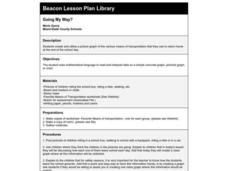Curated OER
Sea Activities
Students explore the sea. In this biology lesson plan, student investigate sea creatures, and sea water. Students discover how to convert sea water into fresh drinking water as well.
Curated OER
Who's the Smartest?
Learners solve a logic problem. In this logic lesson, students use their problem solving skills as they make a chart to determine the answer to a logic problem.
Curated OER
Biodome
Pupils make a biodome out of a recycled soda bottle. In this biodome lesson plan, students make a self contained environment for a plant to grow and watch the plants growth.
Curated OER
Why Not Fabric?
Students investigate art from Native American culture by creating fabric. In this native art analysis lesson, students identify the art of Plains Indians and discuss how it is represented in their fabrics, beads and decorations. Students...
Curated OER
China: Dim Sum: Sand Painting: Mandalas Lesson
Students discover the art form of mandalas and create their own sand paintings. In the process, students explore the history of this art form in Tibetan culture.
Curated OER
WRITE? NO WAY!
Students discover the right brain-left brain differences and then think about how to break down some of their self-criticism to try writing.
Curated OER
Imaginative Picture Writing
Young scholars create a book about clouds after the teacher reads the book, "It Looked Like Split Milk".
Curated OER
Spaghetti Measure
Middle schoolers receive a copy of a "Spaghetti Measure" task sheet along with the scoring rubric. Students preview the task and the rubric prior to starting the task. tudeThey determine the circumference of a circle of spaghetti that...
Curated OER
Launching Rockets
Second graders discuss experiences of watching a rocket launch either on television or in person before making paper rockets. They make and color rockets which they attempt to launch using a strong breath blown through a straw at the...
Curated OER
Out of Sight, Out of Mind
Students analyze and graph the waste created in a typical lunch period. They increase awareness of various types of garbage students create during a lunch period. They construct and label a graph of lunch waste. They brainstorm...
Curated OER
On the Move
Pupils see if they can get their perceptions of movement expressed in images.
Curated OER
In My Dream
Learners listen to various selections of music and discuss the use of form in musical compositions. They choreograph and perform movements to correspond with identified forms.
Curated OER
Miniature Stained Glass Designs
Third graders view examples of previous miniature stain glass designs. After making their own frame out of craft sticks, they create their own design using colored paper. They outline each piece with a black marker and share them with...
Curated OER
Life Through a Microscope
In this microscope usage worksheet, 7th graders complete an introduction packet that takes them through several lab activities that helps introduce and familiarize them with using the microscope.
Curated OER
Geo-Town
Second graders use a checklist to construct a Geo-Town map including a compass rose, a map key, and a paragraph about a walk around Geo-Town, using appropriate geometric and directional vocabulary to identify the two-dimensional figures...
Curated OER
Pythagorean Theorem Investigation
Eighth graders investigate the Pythagorean Theorem and practice applying the theorem to various triangles. Finally, in the next lesson in the sequence, 8th graders create a song or a story to help them remember the Pythagorean Theorem.
Curated OER
SAMMY DISCOVERS SHAPES AT SCHOOL
Students study maps and use them for real world experiences.
Curated OER
Going My Way?
Students discuss how each one of them leaves school each day. They create and analyze a class graph displaying the information collected.
Curated OER
Persistence of Vision Tube
Students demonstrate how individual pieces of data combine to produce complete images.
Curated OER
Modern and Contemporary Art at the Art Institute
Pupils view and discuss Modern and Contemporary Art at the Art Institute of Chicago. Students interpret works by Miro, Oldenberg, Cornell and de Vlaminck and discuss how they feel when viewing the pieces.
Curated OER
ADULT ESOL LESSON PLAN--Skills Necessary to Listen, Speak, Read and Write Effectively
Students practice alphabetizing basic word groups (classroom, playground, etc.) with flash cards and a Picture Dictionary. They realize the importance of communication correctly with others through picture/word association.
Curated OER
ESOL Necessary Skills
Students view flash cards with basic vocabulary pictures on them and match them to the vocabulary words. They cut the pictures apart and glue the words on the back. They play concentration with a partner matching the word with the...
Curated OER
Design Notebook
Students create a notebook where they record their plans, designs, revisions, problems, and solutions for a designated project. They examine various samples of design notebooks used by professionals, and develop their own notebook.
Curated OER
Graphing the Elephant Seal Population Data
Students are able to graph data that they generated in the elephant seal exercise using proper format and labeling. They are able to interpret the graphs they created and make A) conclusions, and B) predictions based on that graph.

























